|
80x5 -
240x3 -
240x4 -
320x1 -
320x2 -
320x3 -
640x1 -
640x2
Set display option above.
Click on
images to enlarge. |
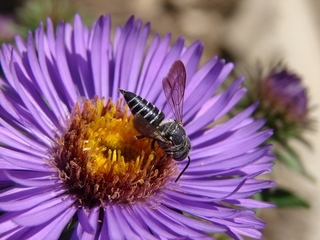
© Copyright John Ascher, 2006-2014
· 9
Coelioxys sayi |
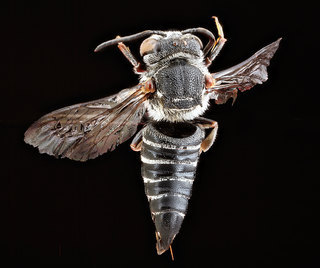
© Copyright source/photographer
· 9
Coelioxys sayi, -female, -back 2012-06-07-14.59.15 |
|
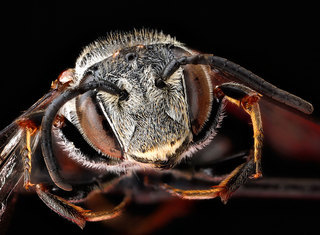
© Copyright source/photographer
· 9
Coelioxys sayi, -female, -face 2012-06-07-15.04.50 |
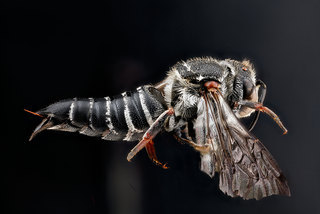
© Copyright source/photographer
· 9
Coelioxys sayi, -female, -side 2012-06-07-15.12.41 |
|
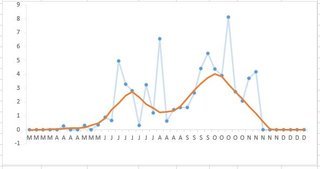
© Copyright source/photographer
· 9
Coelioxys sayi, Mid-Atlantic Phenology |
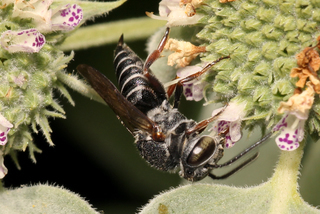
© Copyright Hadel Go 2014-2015
· 9
Coelioxys sayi Says Cuckoo-leaf-cutter |
|
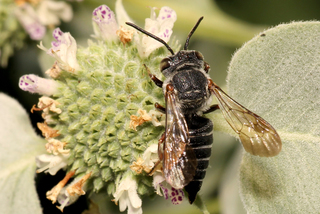
© Copyright Hadel Go 2014-2015
· 8
Coelioxys sayi Says Cuckoo-leaf-cutter |
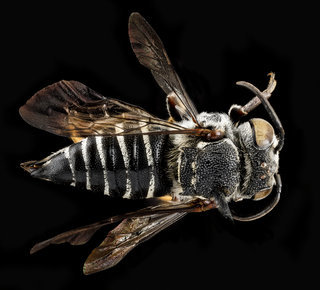
© Copyright source/photographer
· 7
Coelioxys sayi, back, F, Tennessee, Haywood County |
|
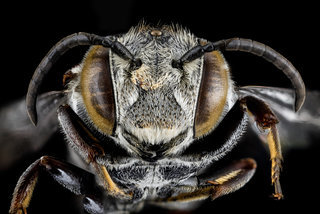
© Copyright source/photographer
· 7
Coelioxys sayi, F, face, Tennessee, Haywood County |
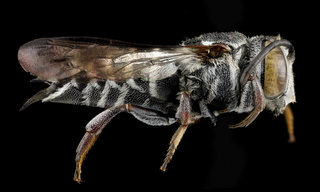
© Copyright source/photographer
· 7
Coelioxys sayi, F, side, Tennessee, Haywood County |
|
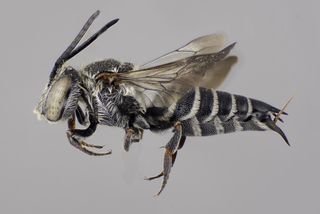
© Copyright Laurence Packer 2014
· 7
Coelioxys sayi fem lat comp ps |
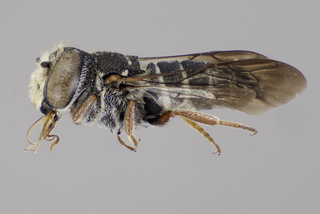
© Copyright Laurence Packer 2014
· 7
Coelioxys sayi male lat comp ps |
|
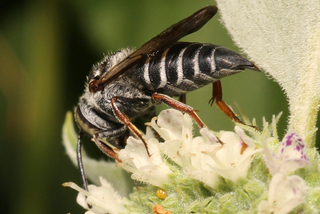
© Copyright Hadel Go 2014-2015
· 7
Coelioxys sayi Says Cuckoo-leaf-cutter |
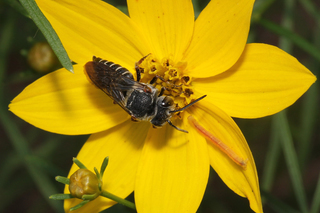
© Copyright Hadel Go 2014-2015
· 7
Coelioxys sayi Says Cuckoo-leaf-cutter |
|
Overview |
Reprinted with permission from: Mitchell, T.B. 1962 Bees of the Eastern United States. North Carolina Agricultural Experiment Station Technical Bulletin No. 152.
FEMALE—Length 9.5-12 mm.; black, tegulae more brownish-piceous, tibiae and tarsi more or less reddened; eyes very slightly convergent below; lateral ocelli subequally distant from margin of vertex and each other, this space not much greater than their diameter, considerably more distant from eyes; cheeks much narrower than eyes, subangulate and slightly concave below, but this area not sharply differentiated from that above; clypeus rather flat toward upper margin but much thickened apically, the margin somewhat incurved medially, forming two rather obtuse, rounded angles; median length of labrum slightly greater than basal width; upper margin of mandible rather broadly produced toward base, the median tooth rather small but distinct; punctures quite coarse and deep, rather sparse between eyes and ocelli, somewhat closer along posterior border of vertex, contiguous on cheeks, irregular and coarse just below anterior ocellus, becoming very densely and finely rugose between and below antennae and over clypeus, a quite distinct, raised, impunctate, longitudinal line between antennae; pubescence of head and thorax entirely pale, more or less yellowish, rather copious around antennae and below ocelli, but becoming subappressed and very short on supraclypeal area and clypeus, somewhat more elongate on each side of face, the apical thickened margin of the clypeus with very dense, elongate, pale yellowish pubescence; pubescence of cheeks very short, somewhat more dense toward hypostomal area, quite short and sparse over most of pleura, becoming somewhat more dense anteriorly and posteriorly, but not forming distinct fringes; propodeum with copious elongate, pale yellowish pubescence; transverse carinae of tubercles low but evident, extended slightly along anterior margin of scutum; scutellum rather broadly outcurved posteriorly, posterior and dorsal surfaces not sharply differentiated; axillae very short, not much longer than basal width, acute tip projecting but very slightly beyond margin of scutellum; coxal spines very short, reduced to subtriangular, carinate tubercles; wings quite deeply infuscated, 2nd recurrent vein reaching 2nd submarginal cell much nearer apex than 1st does to base; scutum coarsely and deeply punctate, punctures slightly separated medially but becoming crowded laterally; punctures of scutellum coarse, slightly separated, those on axillae about equally coarse but very close; punctures of pleura very coarse, contiguous and rather shallow, becoming subreticulate above; lateral faces of propodeum smooth but very dull, posterior face somewhat more shining, with minute, scattered and vague punctures, dorsal area velvety, becoming obscurely subreticulate along upper margin; basal abdominal tergum shining, punctures coarse and deep, rather widely separated medially, becoming quite close and somewhat finer laterally, apical margin slightly depressed, with an entire, dense, white fascia; transverse grooves of terga 2 and 3 subapical medially, becoming more basal toward sides, the more basal punctures of the discs quite deep, distinct, rather coarse and regular, apical areas largely impunctate medially, becoming rather closely punctate at extreme sides, apical margins deeply depressed and completely white fasciate; terga 4 and 5 not definitely grooved, rather closely punctate basally, more sparsely so apically, the apical margins deeply depressed and completely white fasciate; tergum 6 abruptly narrowed just beyond mid point, thus obtusely angulate, closely, deeply and rather finely punctate between this and base, with a faint, median, longitudinal line which continues as a distinct ridge to apex, surface deeply excavated on each side of this and sides just beyond the angle rather deeply excavated, tip very narrowly rounded (fig. 65); sternum 6 narrow and elongate, gradually narrowed apically, with a pair of very minute but distinct notches on each side toward tip, this area slightly longer than breadth at the notches, subacute apically; sterna 1-4 shining, coarsely and deeply punctate, rather uniformly close in large part, apical margins depressed, yellowish-hyaline, completely white fasciate; sternum 5 subtriangular in outline, basal punctures quite deep and distinct, but apex becoming dull, finely and densely tessellate or roughened, punctures fading out from base, lateral oblique margins quite distinctly white fasciate.
MALE—Length 9-10 mm.; black, tegulae yellowish-hyaline, tarsi entirely, and tibiae at base and apex, ferruginous; eyes rather strongly convergent below; lateral ocelli sub- equally distant from margin of vertex and each other, considerably more distant from eyes; cheeks somewhat narrower than eyes, carinate posteriorly, deeply concave over most of lower half adjacent to the carinate posterior margin, this carina produced below into an obscure angle, the concavity shining and bare; clypeus very slightly convex, apical margin nearly straight, densely covered with pubescence; median length of labrum about equal to basal width; median tooth of mandible distinct; punctures coarse and deep, rather close behind ocelli, but with wide, intervening, impunctate spaces between ocelli and eyes, cheeks becoming coarsely rugoso-punctate or reticulate, area below ocelli coarsely reticulate, becoming very densely rugose beneath the pubescence below antennae and over clypeus; pubescence entirely white on head and thorax, dense below antennae and along margins of hypostome; pleura with rather short, thin pubescence, forming indefinite, white fringes along margins; pubescence of propodeum more elongate and thin; transverse carina of tubercles very low and inconspicuous, somewhat obscured by pubescence; posterior margin of scutellum very slightly out- curved, posterior and dorsal surfaces not sharply differentiated; axillae subtriangular, very short, not much longer than the base is broad, projecting only slightly beyond margins of scutellum; coxal spines well developed, elongate, somewhat spatulate, with rounded tips, densely pubescent posteriorly; wings rather deeply infuscated over apical half, 1st recurrent vein reaching 2nd submarginal cell nearer base than 2nd does to apex; scutum coarsely and deeply punctate, punctures slightly separated medially, becoming densely crowded at extreme sides; scutellum coarsely rugoso-punctate or reticulate, the axillae somewhat more finely so; punctures of pleura rather shallow but coarse and subcontiguous, with a few shining interspaces evident below, becoming coarsely reticulate above; lateral faces of propodeum dull, very finely roughened, posterior face somewhat more shining, with very minute, close and vague punctures, dorsal area narrowly velvety below, the upper half becoming finely and obscurely rugose; basal abdominal tergum shining, punctures coarse, deep and quite close, only slightly separated medially, apical margin depressed, yellowish-hyaline and completely white fasciate; transverse grooves of terga 2 and 3 complete, subapical in position at center, becoming more basal at extreme sides, the more basal punctures deep, regular and quite coarse, the more apical part of disc shining and impunctate in large part, becoming rather irregularly and closely punctate at extreme sides; tergum 2 with a pair of very small, but deep and distinct foveae on each side, just beyond the groove, apical margins of both terga deeply and narrowly depressed, yellowish-hyaline and white fasciate; terga 4 and 5 somewhat depressed at base, this area white tomentose, interrupted medially, apical margins deeply and abruptly depressed, more or less hyaline, white fasciate at sides, interrupted medially on each, discs deeply and rather coarsely punctate medially, where they are rather sparse, but becoming closer and finer toward lateral limits; tergum 6 fasciate at base on each side of center, surface somewhat shining, closely, finely and distinctly punctate, deeply excavated just before tip, dorsal protuberances flared, very short, subtriangular, ventral spines more narrow and elongate, tips narrowly rounded, lateral spines distinct and acute (fig. 66); sterna 1-4 shining, coarsely, deeply and rather uniformly punctate, punctures only slightly separated in general, apical margins depressed yellowish-hyaline, completely white fasciate; disc of sternum 4 not appreciably emarginate medially, but the depressed rim with a very small, median, apical emargination; sternum 5 largely retracted, the margin broadly and shallowly incurved medially, submembraneous, rather densely tomentose on each side; sterna 6 and 8 entirely retracted, 6 triangularly acute apically, rather densely long pubescent on each side, 8 strongly narrowed apically, the tip slightly incised; gonocoxites of genital armature much exceeding penis valves in length, somewhat compressed, bearing numerous, rather elongate, erect, fine hairs.
DISTRIBUTION—British Columbia to Ontario, south to Texas and Florida; March to October.
FLOWER RECORDS—Afzelia, Aralia, Asclepias, Aster, Bidens, Coreopsis, Daucus, Erigeron, Haplopappus, Helenium, Helianthus, Koellia, Lespedeza, Linaria, Melilotus, Nepeta, Phaseolus, Polygonum, Rhus, Rubus, Solidago, Spiraea, Trifolium and Viola. Robertson (1929) lists the following additional genera: Amorpha, Blephilia, Crotalaria, Dianthera, Eryngium, Eupatoriurn, Geranium, Heliopsis, Monarda, Petalostemum, Psoralea, Rudbeckia, Symphoricarpus, Thaspium and Verbena.
HOST—Megachile mendica.
This parasite has been reared from nest of Megachile mendica by K. V. Krombein at Lake Placid, Fla.
Extracted from: Baker J.R., (1975). Taxonomy of Five Nearctic Subgenera of Coelioxys (Hymenoptera; Megachilidae). The University of Kansas Science Bulletin Vol. 50, No. 12, pp.649-730.
FEMALE. Agrees with description and figures of Coelioxys rufitarsis except as follows: (1) Length 95-12 mm; (2) integument granular on vertex between punctures, less so on thorax; (3) pubescence white, slight golden-brown tinge on clypeus. golden on tarsi; (4) ocular hairs of medium length (about 0.08 mm); (5) clypeus covered with short appressed setae plus scattered erect setae; surface visible, margin thickened and slightly bibbed (Fig. 22G); (7) paraocular area almost obscured by appressed and erect setae about 0.2 mm long; (8) rest of face rugose with long (0.45 mm) mediosagittal ii punctate ridge extending from ocellar area; (9) clypeoantennal distance subequal to antennocular distance and less than interocellar distance; (10) ocellar area coarsely punctured; (14) hypostomal area of gena with setae subequal to setae on disc; (15) mandible with outer margin straight (Fig. 22G); (16) scutum with erect setae shorter and less conspicuous than shown in Figure 21; (17) lateral surface of mesepisternum moderately punctured with short (0.2 mm) slender setae on disc and distinct anterior and posterior fasciae; (18) scutellum with posterior margin less rounded than shown in Figure 21; (20) metanotal setae sometimes erect, sometimes prostrate medially; (22) tergum 3 with gradular groove medially, fasciae on terga 1-5 not as conspicuous as shown in Figure 21; tergum 6 with lateral angles as shown in Figure 24H.
MALE. Agrees with description and figures of Coelioxys rufitarsis except as follows: (24) Length 9-10 mm; (26) Pubescence as in female (3 above); (27) ocular hairs short (about 0.8 mm); (28) clypeus obscured by long, copious setae (about 0.3 mm); (30) paraocular area obscured by copious setae (about 03 mm long); (31) rest of face rugose, punctured closely up to ocellar area, with copious setae (about 03 mm long); (33) ocellar area as in female (10 above); (34) ocelloccipital distance greater than interocellar distance, less than ocellocular distance; (35) vertex usually with impunctate areas lateroposterior to ocelli; (36) gena with ventral angle about 900; (37) excavation of hypostomal area of gena with setae of anterior fascia shorter than setae on disc; (39-43) scutum, mesepisternum, scutellum, axilla, metanotal setae as in female (16-20 above); (45) gradular grooves of terga 2, 3 as in female (22 above); fovea on tergum 2 about 0.03 mm long; 0.06 mm wide (as in Fig. 25G); dorsal spines of tergum 6 variable, sometimes more, as, or less slender than shown in Figure 25C; (47) genital armature with setae not as abundant on gonocoxite apically as shown in Figure 26F.
HOST RECORDS. Medler (1965) reported Megachile mendica to he a host of Coelioxys sayi. This bee has also been recovered from nests of M. brevis.
DISTRIBUTION AND SEASON OF FLIGHT. Except for scattered records from the West, Coelioxys sayi is confined to the eastern United States (Fig. 35).
This bee is in flight from at least March
3 in Florida, April 30 in Texas, and May
8 in Kansas to October 3 in New York
and October 23 in Texas.
HABITAT. In the eastern United States, Coelioxys sayi has been collected from areas classified as eastern broadleaf, eastern broadleaf and needleleaf forests, and eastern grassland and forest combinations. In the West, C. sayi has been taken from areas classified as western needleleaf forests. However, as with C. octodentata, more specific habitats have been reported for its host Megachile mendica, as well as for C. sayi (Medler, 1%5). These bees have been reared from trap nests placed in open woodland, savana, and forest-edge habitats. The nests usually occur well above the ground (although M. mendica has been observed to nest in the ground). C. sayi has been taken from M. brevis nests at ground level, and has been observed at a woodland edge flying slowly along the ground as though searching for host nests.
GEOGRAPHIC VARIATION. As in the case of Coelioxys alternata, leg color in C. sayi does not seem to be meaningfully correlated to geography. Bees with all degrees of leg color occur at many localities throughout the range, and the chance of finding any particular condition at a given location appears to hinge on the sample size rather than latitude and longitude. As with C. texana, however, wing color does vary geographically. Bees from Florida to Texas have slightly darker, very slightly more yellowish wings than those from elsewhere in the distribution.
COMPARATIVE COMMENTS. Females of Coelioxys sayi are most similar to those of C. rufitarsis and C. octodentata although the clypeus is bibbed in C. sayi and straight in the other two species. In the West, C. sayi might be confused with dark females of C. novomexicana but differs conspicuously in the setal fringe of the clypeus which is posteriorly directed (ventrally directed in C. novomexicana). Males of C. sayi are most easily confused with those of C. octodentata, differing mainly in the reduced posterior margins of the gradular grooves of terga two and three (well formed in C. octodeatata).
|
|
|
Identification | |
Sayi individuals can be difficult to distinguish from octodentata individuals. Females can be clearly identified by the shape and vestiture of the clpyeus. From top view, the clypeus is swollen laterally. This "swollen" area, is actually a thickening of the clypeal rim. This thickened vertical face of the rim is covered in dense, short hair and is very distinctive of sayi females in general. The males are harder to distinguish from octodentata. Differences include:
1- The distance between the lateral ocelli is nearly equal to or slightly greater than the distance between lateral ocelli and the vertex margin. Be sure to meansure this character carefully, avoiding just eye-balling it.
2- Vertex tends to be black or dark brown.
3- Legs tend to be reddish/orange at their extremities, darkening through the femur.
Of these characters, the ocelli/vertex character is the most dependable.
|
|
|
Names | |
|
|
| Supported by | |
Updated: 2024-04-25 22:15:35 gmt
|